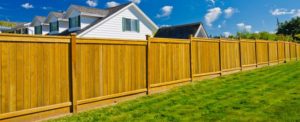Breaking Down the Differences: Yellow Pine vs White Pine
 As anyone who has looked into installing a wood fence can tell you that there are several different types of wood you can choose from. Yellow pine and white pine are two of the most common and affordable options.
As anyone who has looked into installing a wood fence can tell you that there are several different types of wood you can choose from. Yellow pine and white pine are two of the most common and affordable options.
White pine is a softwood with a low density and even grain. White pine is prone to developing long vertical cracks called “checks.” Checks will not threaten the strength or integrity of the wood. They are simple the result of the post relieving the pressure from the pressure-treated applied chemical.
White Pine Advantages
- Affordability
- Less twisting and bowing than yellow pine
- Almost impenetrable when treated with ACQ2 treatment
White Pine Disadvantages
- More expensive than yellow pine
- Does not stain well due to treatment
- It tends to crack versus twist. Cracks are fine but if you don’t like these.
Yellow pine is a hardwood that has a very high density and has an uneven grain. Yellow pine also develops checks. Setting yellow pine posts as soon as you get them will help curb some of the bowing and twisting.
Yellow Pine Advantages
- Affordability
- Almost impenetrable when treated with ACQ2 treatment
- Excellent strength-to-weight ratio
- Extra longevity in soil
Yellow Pine Disadvantages
- Prone to some bowing and twisting
- Does not stain well due to treatment
- Green tint does not fade
When it comes right down to it, white pine and yellow pine are still similar woods. Pine in general is a more economical wood and is prone to some slight warping. Yellow pine is stronger and heartier, but warps more than white pine. White pine tends to stay truer to its form, but is softer and weaker than yellow pine.
Go to America’s Fence Store to explore our variety of wood fencing products today.
